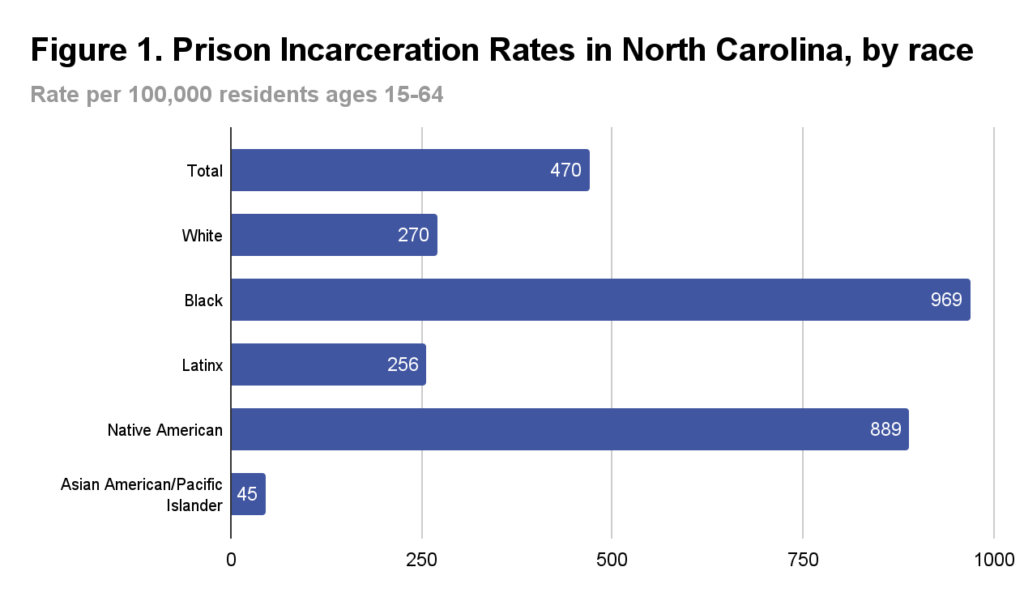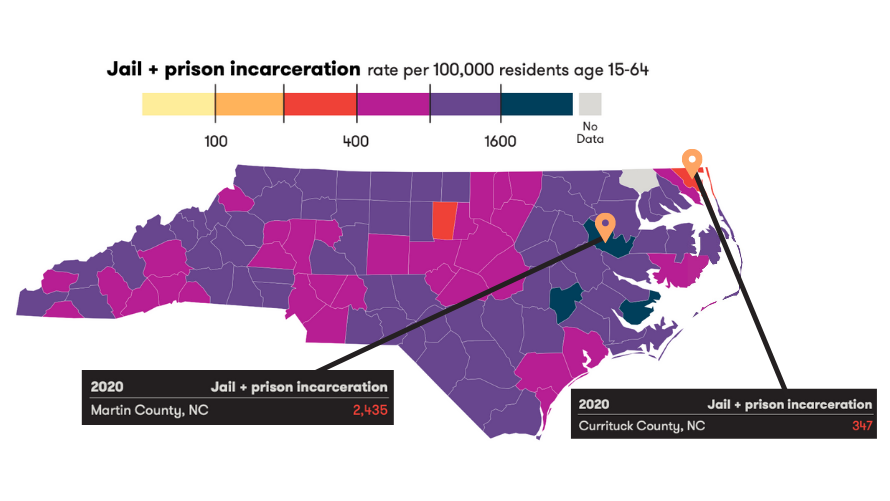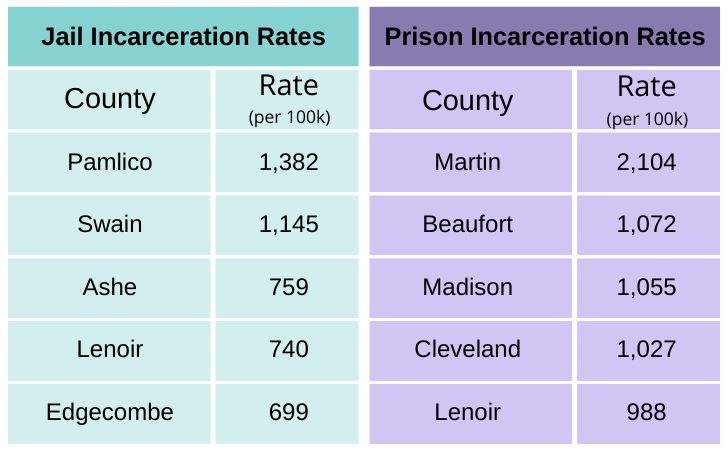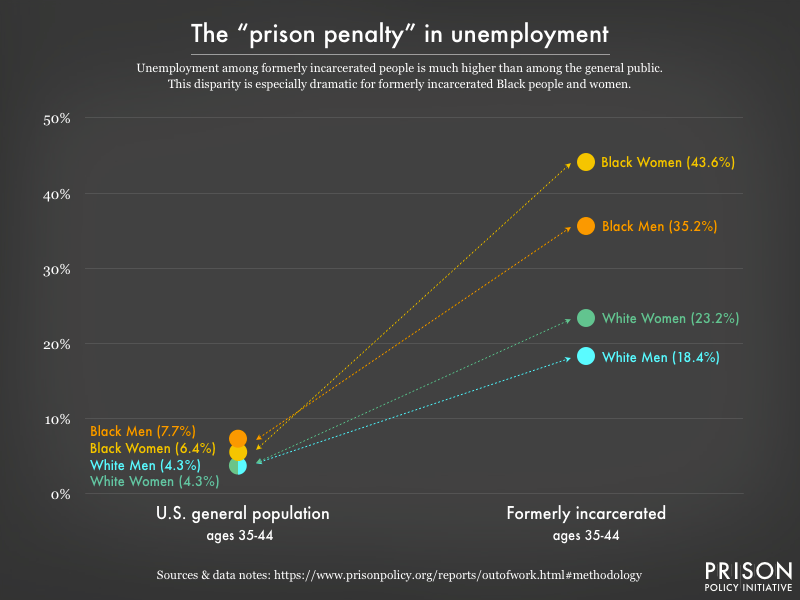The Employment of Justice-Involved Persons
Data Brief by Brodie Smith, IEI Policy Intern
Completed 8/12/2022
Who are Justice-Involved Persons?
The term “Justice-Involved” refers to anyone who has had interaction with the criminal justice system as a defendant. Being “Justice-Involved” does not necessarily mean that one is actively incarcerated; this interaction with the criminal justice system can vary from being formerly incarcerated in a jail or prison, being placed on parole, or even being temporarily incarcerated while awaiting a trial.
Highlights
- In North Carolina, approximately 54,400 individuals were incarcerated at the end of 2019, which equates to roughly 660 out of every 100,000 adult residents.
- As of 2020, Black people make up about 23% of the general population in North Carolina; however, they make up 51% of the incarcerated population.
- Within the first year of release, only about 37% of formerly incarcerated individuals are able to find employment nationally.
- Nationally, formerly incarcerated Black women face unemployment at much higher rates than any other demographic group at 43.6%, with formerly incarcerated White men facing unemployment at 18.4%.
- Job turnover rates for people with criminal records are 12% lower than that of the general public.
Prison vs. Jail
The terms “prison” and “jail” are commonly used interchangeably, but there are important differences between the two. Jails are locally run facilities that primarily hold unconvicted individuals who have been arrested and are still awaiting a resolution to their case. Many people are in jail due to the inability to afford bail, fines or various fees, while others are in jail serving shorter sentences for misdemeanor or low-level felony convictions. Prisons are state or federal institutions where individuals who have been convicted of crimes are sent to serve sentences of imprisonment.
United States Data on Justice-Involved Persons
Here in the United States, approximately 6,344,000 individuals were under the supervision of adult correctional systems at the end of 2019. Of this population, 4,357,700 persons were under community supervision, also known as parole or probation, and the other 2,086,800 (about 810 persons per every 100,000 U.S. adult residents) were actively incarcerated in prisons (1,430,800 persons) and local jails (734,500 persons) across the country. In all, this equates to roughly 1 in 40 adult U.S. residents (2.5%) under some form of correctional supervision. To learn more about national incarceration data, visit the footnote from the Prison Policy Initiative, “Mass Incarceration: The Whole Pie 2022”.
North Carolina Data on Justice-Involved Persons
If we zoom in further and take a look at North Carolina, the total population for those under adult correctional supervision is approximately 145,300 persons (roughly 1,760 out of every 100,000 North Carolina adult residents). Of all the individuals in North Carolina under adult correctional supervision, about 54,400 persons (roughly 660 persons for every 100,000 U.S. adult residents) were actively incarcerated in either prisons or jails at the end of 2019. If we break down the approximate 54,400 people incarcerated in North Carolina, roughly 34,100 were in prisons and the other 20,300 were in local jails, and about 82% of those individuals in local jails make up the pretrial jail population. The pretrial jail population is made up of individuals who have been detained and are awaiting a trial—meaning that they are still legally innocent. The majority of the pretrial jail population is being held due to their inability to afford money bail, while others are held due to “holds” placed by probation, parole or ICE offices.

Over the last several decades, the percentage of women incarcerated in North Carolina has grown much more rapidly than that of men. In 2019, women made up approximately 13.7% of the total jail incarceration population and 7.8% of the total prison incarceration population in North Carolina.
The gap between incarceration rates for people of color—Black people specifically—and White people have narrowed in recent years. However, Black and Native American people are still incarcerated at strikingly higher rates than White people. As seen in Figure 1, the incarceration rates for Black and Native American peoples in North Carolina are much higher than those of White people as well as the statewide total. It is estimated that Black individuals make up about 23% of the North Carolina population, yet they hold the majority in prisons and jails with 51% in 2020, while White persons make up about 63% of the population and only 40% of the incarcerated population.
County Data on Justice-Involved Persons*
*County data is not conclusive on whether the data from each county is based on an individual’s county of residence or the county where the crime was committed.
Across North Carolina’s 100 counties, the incarceration rates vary greatly depending on where you are. The Vera Institute of Justice uses data collected from the Bureau of Justice Statistics, Annual Survey of Jails, Census of Jails and the National Prisoner Statistics program to create an interactive map of the United States, including county-level analysis. Through this map you are able to visualize incarceration trends such as jail admissions, jail and pretrial jail incarceration, prison incarceration and total (both prison and jail) incarceration. In the map, you can see the total jail and prison incarceration rates by county for North Carolina, with the exception of Gates County which showed no data. Of these counties, Martin County leads with 2,435 persons per 100,000 being incarcerated in either jails or prisons. The county with the lowest incarceration rate is Currituck County with 347 persons per 100,000.

Jail and prison incarceration rates can also be examined separately. For jail incarceration rates, Pamlico County has the highest rates with 1,382 persons per 100,000, and for prison incarceration rates, Martin County ranks again with 2,104 persons per 100,000. The top 5 counties for each category can be seen in the table below.

Employability
We see how North Carolina incarcerates individuals, but how do those who have been incarcerated or involved in other aspects of the justice system perform in the labor market? According to an article published by the North Carolina Department of Commerce, Labor & Economic Analysis Division, the share of former offenders who actually were able to find work in the state within a year after release from state prison dropped from 62% in 1998, to an astonishingly low 39% as of 2014. Similar data can be seen for those released from federal prison as well, with about 37% of those released from federal prison in 2010 being able to find work within the first year post-release.
If we look at the actual unemployment rates of formerly incarcerated persons, we can see that these rates are exponentially higher than those of the general public. Data from the Prison Policy Initiative shows that the unemployment rate as of 2008 for formerly incarcerated persons ages 25-44 was 27.3%. If you compare that statistic to the general public, the number drops by 22.1 points to an unemployment rate of 5.2%. Among this same population (formerly incarcerated persons ages 25-44), they are shown to be more active in the labor market compared to the general public. Of those who are formerly incarcerated, approximately 93.3% are either employed or actively looking for work, however only 83.8% of the general public are doing the same.
In this same study, they explore the differences between race and sex for those formerly incarcerated. It was found that of those formerly incarcerated Black women had the highest unemployment rate at a whopping 43.6%, which is nearly seven times the unemployment rate for Black women in the general population (6.4%). Trailing behind Black women is Black men, who experience an unemployment rate of 35.2%, with White women following at 23.2%, and White men having the lowest unemployment rate for formerly incarcerated people at 18.4%. The graph displayed below further highlights the unemployment disparities amongst the different sexes and races.

Assets of Justice-Involved
We know that being employed benefits those who were formerly incarcerated, but what assets do formerly incarcerated persons bring to the table for employers? Across the board, those who were formerly incarcerated or involved in various levels of the justice system showed much higher rates of retention and lower turnover rates. In a study conducted by the ACLU, the average turnover rate for those with criminal records was about 12% lower than the general public. This level of company loyalty can be seen even in the United States Military, where enlistees with felony records were 33% more likely to be promoted to sergeant. Higher retention and lower turnover will greatly benefit businesses when you consider the costs associated with labor recruitment. On top of this deviation and loyalty, formerly incarcerated persons bring a new sense of inclusivity and help create a natural culture in the workplace. According to the Center for Employment Opportunities, when employees are able to come to work as their full authentic selves, it creates a more inclusive community and will strengthen their work ethic. Overall, research shows that “job seekers with criminal histories…are a ‘better pool for employers.’”
Policies and Resources Surrounding Justice-Involved Persons
There are some policies and governmental actions that help formerly incarcerated persons find work, as well as provide incentives to businesses for hiring justice-involved persons. Some of the most prominent policies and programs on the federal level that support justice-involved persons in the workforce are:
The Fair Chance to Compete for Jobs Act of 2019 (S.387/H.R.1076)
Federal legislation that states federal agencies and federal civilian and defense contractors may not request information on arrest and conviction history until a conditional job offer has been extended to the applicant. This bill is similar to “ban the box” laws that have been adopted around the country.
The Work Opportunity Tax Credit
Businesses can capitalize on the Work Opportunity Tax Credit of up to $2,400 for each employee hired within one year of being convicted of a felony or being released from serving a prison term for a felony. This program allows businesses to receive financial incentives for hiring select target groups, one of which being ex-felons.
The Federal Bonding Program
This program provides businesses with a no-cost, $0 deductible federal bond that provides $5,000 worth of coverage for any employee dishonesty committed during the first six months of employment for part-time or full-time employees. This federal program provides opportunities for employers to protect their assets by expanding hiring justice-involved individuals.
North Carolina also imposed statewide policies that would do similar actions to the Fair Chance to Compete for Jobs Act of 2019. Executive Order 158, signed by Governor Roy Cooper on August 18, 2020, implemented fair chance policies at state agencies to increase employment opportunities for people with criminal records. North Carolina joined 35 other states and 150 cities who had similar policies at the time. This executive order removed criminal history questions from the application for state employment, prohibited the consideration of expunged or pardoned convictions, required that necessary background checks not be conducted before the initial interview, and required state agencies to provide a reasonable opportunity for applicants to explain their individual circumstances surrounding past criminal records. This executive order opened up fair chance hiring in North Carolina, and ultimately aided in the reentry process for formerly incarcerated persons.
If you would like to learn more about another organization’s policy recommendations for fair chance hiring, visit the footnote from the Prison Policy Initiative.
Success in Action
The Craven-Pamlico Re-Entry Council was established in January 2011 by Attorney General Holder. This council works to provide formerly incarcerated persons with resources in order to obtain proper health care access, assist with housing access and family stability, and aid in the job seeking process for these individuals. Paris King, a client of the Craven-Pamlico Re-Entry Council, was released from prison in 2019, and with the help and training provided by the council, King was able to find employment at a local Hilton DoubleTree and is now up for promotion. A program like this was able to find King, along with numerous other justice-involved individuals, a place of employment and stability.
The Center for Employment Opportunities (CEO) is a national organization that advances employment opportunities for justice-involved individuals and hires only those with past criminal records. Their Charlotte, NC office connects North Carolinians that fall into this group with employers, such as Bojangles. The CEO has made a goal of employing over 800 justice-involved individuals over the course of the next four years.
The Southern Coalition for Social Justice is one of the many organizations working with policy leaders and local businesses to advocate for justice involved individuals. Their Fair Chance Business Certification Program, in partnership with the Community Empowerment Fund (CEF) of Orange County, NC, provides resources to employers so that they can become Fair Chance Business Certified. To reach this certification, businesses must remove all questions about previous criminal records from the initial job application forms, delay questions about criminal records until a conditional offer has been made to the applicant, and give the applicants a chance to see any and all background checks that are run.
- Categories:


